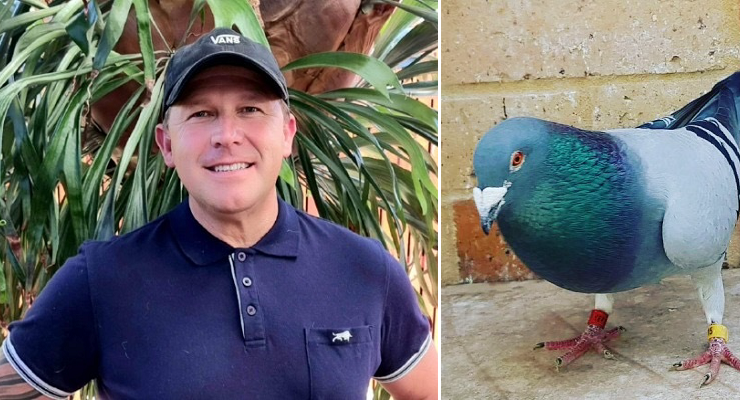
More than 9000 pigeons from 50 countries will today leave their loft and go head to head in the first of five races at the Pattaya International Pigeon Race in Thailand. The competition awards $2.6 million in prize money and tracks a total of 1815km, making it the world’s biggest international “one loft” (meaning all the pigeons head “home” to the same place) racing event.
It consists of four “hotspot” races throughout December — 245km, 280km, 330km and 430km — followed by a grand 530km finale in January, which is signed and certified by the honourable FCI Racing Pigeons Grand Prix.
Australia has sent 13 teams with a total of 72 pigeons, 58 of which have qualified to compete. These teams range from one highflier to 12 birds. Compare that to host-nation Thailand, which has 77 teams, 963 pigeons and 770 qualifiers.
“In the past I’ve sent birds over east, but now I’m wholly and solely focused on this race because it’s the biggest in the world. Why mess with anything else?” competitor and Western Australian pigeon liaison agent David Van Aalst told Crikey.
Van Aalst is one half of “Van Aalst-Magro”, a two-man, 10-pigeon-strong team that has eight qualifying birds flexing their wings for the first 245km flight today. All athletes are nameless (unless they win).
He’s feeling confident after two of his birds placed 207th and 251st in a 220km practice race a few days ago. It was an Australian-bred best.
Before we talk tactics, just how does an Australian pigeon land in Thailand?
Pigeon pre-match warm-up
To get a bird to the start line of an international one-loft meet is no walk in the park. Accounting for air travel, race entry and pre-match primping and priming, it rounds out at about $1000 per pigeon.
On paper, a pigeon must be between 45-60 days old, properly fitted with ID rings (like a car registration number) and hold a vaccine passport.
Much of this falls to Van Aalst as Australia’s international pigeon liaison agent. Based in WA, he manages all outgoing racegoers.
Australian competitors send him their pigeons to go through four weeks of quarantine, vet checks and health and wellness routines. Then there’s to-and-fro with local government to obtain an export licence, and dealings with international animal handlers, before finally the birds board a plane and fly direct from Perth to Bangkok.
“We couldn’t just put them on a plane and send them over. I’ve got pages and pages of messages trying to get this show on the road,” said Van Aalst.
Once they arrive, it’s over to the Thai authorities to keep the biosecurity bonanza going. The birds are microchipped and then taken to their new living quarters. Call it an athletes’ village — pigeons from all over the world housed together under one roof. This loft doubles as the finish line for the race.
Unlike other international sporting events where athletes travel with an entourage of trainers, these pigeons are all given identical treatment upon arrival.
“The Thai carers don’t know who anyone’s pigeon is in the shared loft, only the computer knows. That means there is no chance of foul play,” said Van Aalst.
“We wouldn’t invest our money if we knew they had a hometown advantage.”
The (historical) flight path of the racing pigeon
The one-loft race has been a game-changer for the sport, as there is now less emphasis on competitors mastering the art of pigeon training.
Traditionally, racing pigeons would fly from a shared start line to their respective homes in what pigeon racing documentary filmmaker Jim Jenner called “the sport with a single starting gate and a thousand finish lines”.
Using mobile electronic timing devices, distance was measured, travel time was clocked, and speed was calculated. The fastest bird was declared the winner.
Now it’s a genetics game. As a newcomer to the sport, Van Aalst had given himself three to four years to establish which pigeon pedigrees are best to race in the hot, humid Thai climate.
“You’re ultimately trying to crack the DNA that will perform under the race conditions. I’ve imported 20 to 30 pigeons from Holland, Belgium and the UK, as well as local breeds to try and get the right genetics,” he said.
No ferals take flight
The racing pigeons are very different to your fly-away ferals that frequent the town square. Jenner says “thoroughbred” pigeons are arguably the fastest athlete in any sport.
“The birds in the race have hearts double the size of a feral pigeon. They have a unique 1:1:1 ratio of breath to heartbeat to wing beat which means they can fly at top speed from dawn to dusk,” he said.
They’ve done the daily rounds throughout human history, managing the inboxes of big names like Genghis Khan and Caesar. Homing pigeons were also a founding partner of news agency Reuters.
And here they are today, still sending messages, except this time via livestream to a global audience.
“I get WhatsApp notifications updating me on my pigeon’s progress, but then it also goes to Facebook. We sit here [in Australia] and wait for a visual of a bird flying,” said Van Aalst.
Race post mortem
Like all great migrations, not all pigeons make it to the finish line. Some get lost, others get injured, and there are unfortunate casualties courtesy of birds of prey.
At the end of the event, the top 500 performers will be auctioned off locally, while the remainder are freed.








Thanks, interesting article
From what I can remember, it takes some time and effort to “rehome” a pigeon to a new loft. Wonder how they manage this with so many birds rehoused in the central loft in Thailand.
Yeah how does this work???
Do the owners ship the birds to Thailand, and stay at home whilst officials handle the birds? That seems rather hands off and trusting, or at least, strangely distanced.
How do the birds know where to fly?
Why do the birds even do this? If it were me, I might just fly to the nearest pub or restaurant.
If there’s no actual training of the birds, and this is just something they do because of their instinct to return to the place where they’ve been living for the last fortnight or whatever, then what does winning this race even prove? Is it just a breeding competition?
“At the end of the event, the top 500 performers will be auctioned off locally, while the remainder are freed”
Freed as in let go to become feral pigeons? That seems odd. Do the owners not want them back? Or is “freed” just a euphemism for killed?
Free to let their genetically improved line enhance the performance of our feral pigeons in evading capture, spreading mites and lice, and sh*tting on statues.
What a fascinating glimpse into a genre of international sport that I knew nothing about. I really enjoyed reading this article about the racing pigeons. Thank you.